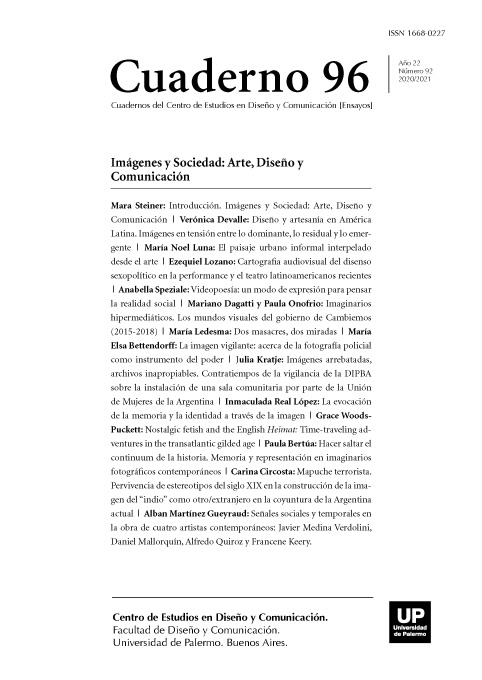Videopoesía: un modo de expresión para pensar la realidad social
Abstract
The genre of videopoetry originated at the end of the 1960s, but for several years, various audiovisual artists and designers have shown renewed interest in it, both in international and national contexts. Each videopoem is unique, and invites you to make more than one reading about it. However, it also has its own internal rules: the juxtaposition of poetic images, the use of the text in the audiovisual space / time and the audiovisual experience that it is proposed to build. Within this genre, different forms of expression are highlighted, which appeal to specific models of representation. This article will describe those works of the genre that involve a reflexive way to account for social reality. This typology of videopoems, which we will call here video-politics, adopts a situated view and finds a poetic mode of representation, recording and documentation of reality that invites reflection on the world represented there. These pieces of audiovisual design are a particular contribution to the collective memory of our contemporary society
References
Alonso García, L. (1996). La oscura naturaleza del cinematógrafo. Raíces de la expresión aurovisual. Valencia: Ediciones de la mirada. Baudrillard, J. 1994. Simulacra and Simulation (Traductora Faria Glaser, S.).
Annarbor: The University of Michigan Press (1981).
Baudry, J-L. (1999). “Ideological effects of the Basic Cinematographic Apparatus”. en L. Braudy y M Cohen (eds.) Film Theory and Criticism. 5th Edition. Oxford: Oxford University Press (1970).
Benjamin, W. (1982). “La obra de arte en la era de la reproductibilidad técnica”. En Discursos interrumpidos I. Madrid: Taurus (1936).
Cantú, M. (2007). “La obra video desde la obra escrita” en M. Cantú y J. La Ferla (comps.), Video argentino: ensayo sobre cuatro autores: Carlos Trilnick, Arteproteico, Marcello Mercado, Iván Marino. Buenos Aires: Nueva Librería.
Darley, A. (2000). Visual digital culture. London: Routledge.
Doelker, Ch. (1982). La realidad manipulada. Radio, Televisión, Cine, Prensa (Traductor Faber-Kaiser, M.). Barcelona: Editorial Gustavo Gili (1979).
Dubois, Ph. (2001). Video, Cine, Godard. Buenos Aires: Libros del Rojas.
Flusser, V. (2001). Una filosofía de la fotografía (Traductor Schilling, T.) Madrid: Síntesis (1983).
Foucault, M. (1976). Vigilar y castigar: nacimiento de la prisión (Traductor Garzón del Camino, A.). México: Siglo XXI (1975).
Heidegger, M. (2000) Carta sobre el humanismo (Traductores de Cortés, H. y Leyte, A.). Madrid: Alianza (1947).
Jait, A. (2014). “Poesía (tecno) experimental argentina a fines del siglo XX: la revista Xul y la experiencia Paralengua”. En C. Kozak (comp.), Poéticas/políticas tecnológicas en Argentina 1910-2010. Buenos Aires: Fundación La Hendija.
Konyves, T. (2011). Videopoetry: A Manifesto. Recuperado de http://issuu.com/tomkonyves/docs/manifesto_pdf
Kozak, C. (2012). Tecnopoéticas argentinas: archivo blando de arte y tecnología. Buenos Aires: Caja Negra.
__________. (2014). Poéticas/políticas tecnológicas en Argentina 1910-2010. Buenos Aires: Fundación La Hendija). Machado, A. (2000). El paisaje mediático. Sobre el desafío de las poéticas tecnológicas Buenos Aires: Libros del Rojas.
Nichols, B. (1997) La representación de la realidad. (Traductor Cerdán, J. y Iriarte, E.) Paidós: Barcelona (1991).
__________. (2001). Introduction to documentary. Bloomington e Indianápolis: Indiana University Press.
Rabiger, M. (1987). Dirección de documentales. Madrid: IORTV.
Sadoul, G. (1972). Historia del cine mundial desde los orígenes (Paris: Flammarion) (Traductor Torner, F.). México: Ed. Siglo XXI (1967).
Sibilia, P. (2008). La intimidad como espectáculo. Buenos Aires: Fondo de Cultura Económica. Xavier, I. 2008. El discurso cinematográfico. La opacidad y la transparencia. Buenos Aires: Manantial.
Zunzunegui, S. (1989). Pensar la imagen. Madrid: Ediciones Cátedra.
Los autores/as que publiquen en esta revista ceden los derechos de autor y de publicación a "Cuadernos del Centro de Estudios de Diseño y Comunicación", Aceptando el registro de su trabajo bajo una licencia de atribución de Creative Commons, que permite a terceros utilizar lo publicado siempre que de el crédito pertinente a los autores y a esta revista.


